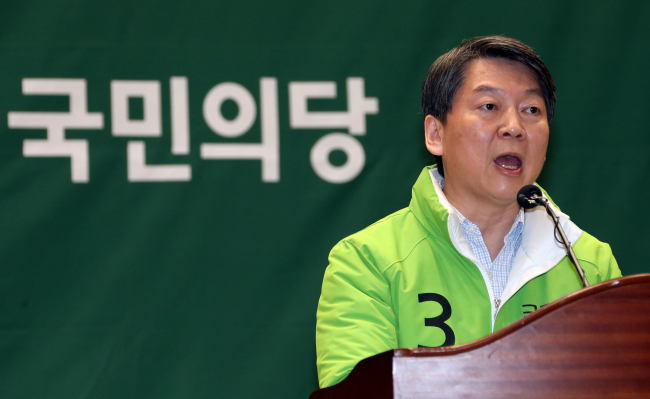This year’s parliamentary election is not only an battle to secure seats in the National Assembly for the upcoming four years but also a guage of public sentiment ahead of next year’s presidential election.
Among the top three potential candidates for presidency, only two will be running in the April parliamentary race — ruling conservative Saenuri Party chief Rep. Kim Moo-sung in Busan and the newborn People’s Party cochairman Rep. Ahn Cheol-soo in the Nowon-A constituency in northeastern Seoul.
Rep. Moon Jae-in of The Minjoo Party of Korea has been laying low since he stepped down from the party leadership earlier this year.
 |
| The Minjoo Party of Korea’s former chairman Rep. Moon Jae-in attends a meeting in support of a candidate running in Daegu on Wednesday.(Yonhap) |
Saenuri head Kim expects little difficulty in winning his sixth parliamentary term in the southeastern conservative stronghold.
Adding to his unrivaled lead in public polls, the risk-taking chairman revved up his presence within the party last week when he stood up to what he saw as President Park Geun-hye’s interference in the party’s nomination process.
 |
| Saenuri Party leader Rep. Kim Moo-sung attends a debate in Seoul on Wednesday. (Yonhap) |
By successfully preventing the party from allocating candidates to run against ranking defectors such as Lee Jae-oh and Rep. Yoo Seong-min, Kim consolidated his position as the leader of the “non-Park” faction.
Having distanced himself from the current administration, Kim’s goal is to lead the party to victory, in which case he may gain the political momentum for his presidential candidacy.
Moon, on the other hand, faces a more complicated battle.
His greatest plus-point as of now is that he has stayed out of the nomination dispute and the consequent negative public sentiment, which has let him keep his reputation relatively intact.
According to most local pollsters in the third week of March, Moon had the highest support among potential presidential runners, maintaining a 10-week lead.
But for his presidential bid to be competitive, he will need two things: incumbent leader Kim Chong-in’s cooperation, and a strong Minjoo Party presence in the Assembly.
The interim chief Kim, who is listed as the party’s No. 2 candidate for proportional representation, has been seeking to erase the legacies of Moon’s leadership, as well as that of former President Roh Moo-hyun, who belonged to the party’s predecessor.
 |
| People’s Party co-chairman Rep. Ahn Cheol-soo speaks during a rally held for the metropolitan constituencies at the National Assembly on Wednesday. (Yonhap) |
Minor party representative Rep. Ahn faces a double whammy. Not only does he have to lead his new party into winning 40 seats as promised, but he also has a harder fight than Kim in his Nowon-A constituency, where he is closely rivalled by Saenuri candidate Lee Jun-seok.
While the respective ranking figures face their battle, parties are striving to win an upper hand in the Seoul-Gyeonggi metropolitan region, which is often considered a central barometer of the nation’s political sentiment.
In the 2012 elections, amid heightened public resentment against the former Lee Myung-bak government, the opposition bloc took a sweeping 61.6 percent of votes in Seoul-Gyeonggi. But in the 2008 elections, which came soon after Lee’s election, the then-Grand National Party won 72.9 percent, reflecting the support for the new administration.
South Korea will elect new National Assembly members in a general election on April 13. The Korea Herald is publishing a series of articles on candidate agendas, election trends and notable runners leading up to the race. This is the eleventh installment. -Ed

